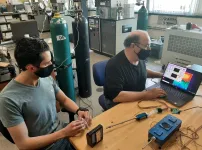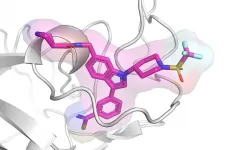(Press-News.org) KINGSTON, R.I. - May 14, 2021 - We are frequently reminded of how vulnerable our health and safety are to threats from nature or those who wish to harm us.
New sensors developed by Professor Otto Gregory, of the College of Engineering at the University of Rhode Island, and chemical engineering doctoral student Peter Ricci, are so powerful that they can detect threats at the molecular level, whether it's explosive materials, particles from a potentially deadly virus or illegal drugs entering the country.
"This is potentially life-saving technology," said Gregory. "We have detected things at the part-per-quadrillion level. That's really single molecule detection."
Broad-Based Applications
Because Gregory's sensors are so small and so powerful, there is a wide range of applications.
"The platform is broad-based, so you can apply it to lots of different venues, with lots of different end users," said Gregory.
While his research is largely funded by the Department of Homeland Security, other government agencies have taken notice of Gregory's sensors.
The Department of Defense may be interested in using it to monitor wounds in soldiers and to detect roadside improvised explosive devices (IEDs).
If a soldier or first responder suffered an open wound from shrapnel, Gregory's sensors could help determine if the wound became infected.
"Hydrogen peroxide generated by the human body for wounds is an indication of how good or how bad antibiotics are working to fight the wound," said Ricci. "Our sensor could be used as a wearable device to sniff out peroxide coming from the wound at the part-per-billion level."
At Miami Heat basketball games, dogs have been used to sniff traces of COVID-19 coming from the pores in people's skin. In an article published in the prestigious journal Nature, Gregory stated that his sensors could be used for the same purpose.
"Where dogs are detecting it from the skin, our sensors would detect it from biomarkers in people's breath," Ricci said, who is from West Warwick.
The Coast Guard has shown an interest in using the technology to "sniff out" illegal drugs being smuggled into the United State aboard ships.
Shrinking the 'Digital Dog Nose'
"Anything that can typically be sniffed out by a dog we can do," said Gregory. "That's why we've called it the Digital Dog Nose."
The Digital Dog Nose was featured on shows such as CBS This Morning in November 2019, but what was once the size of a toolbox has been reduced to a quarter of the size of a pack of cigarettes.
"By decreasing the thermal mass of the sensor, we've decreased the amount of power required to run the sensor," said Gregory. "We started with a thermal mass on the order of grams. Now the thermal mass of our sensor is on the order of micrograms."
One of the keys to making a device as small and powerful as Gregory's is to find the right battery.
"We have partnered with a company that makes very thin, low-mass batteries in Colorado called ITN Energy Systems," Gregory said. "They make lithium batteries that are no thicker than a piece of paper. The process has been about finding the right partners, which helps us improve our catalysts and improve our sensor platform."
Passing the Test
In March 2021, the Naval Research Laboratory brought its mobile testing unit to URI's W. Alton Jones Campus to put Gregory's explosives sensors and others to the test.
"They set up a field test outside using their vapor test bed," said Ricci. "They were able to select an explosive molecule and deliver it to the sensor system. Knowing what the level was, they wanted to see how our sensor would respond. One of the tests was at the part-per-quadrillion level."
Staying a Step Ahead
As bad guys have developed new explosives or new ways to improvise on existing explosives, the good guys have tried to stay a step ahead.
"The Department of Homeland Security has asked us to be flexible enough to anticipate and adapt to emerging threats that may come several years down the road," said Gregory. "We can tweak our catalysts for a specific molecule that is the current threat. That's what we do with biomarkers. That's what we do with drugs. What's nice about this platform is that it's flexible."
Coming a Long Way
The sensors Gregory and Ricci have developed have been tested and improved upon over a long period of time. The professor's research was originally funded 20 years ago by the Defense Advanced Research Projects Agency (DARPA), a research and development agency of the United States Department of Defense that is responsible for the development of emerging technologies for use by the military.
After two years of DARPA funding, the Army funded the project for a year. The Department of Homeland Security has provided funding ever since.
"At the time, this research was very novel and very different," said Gregory. "DARPA funds projects that are high risk, high reward. We've demonstrated that the gamble they took on our concept back then has paid off."
Michael Silevitch, the Robert D. Black Distinguished Professor of Engineering at Northeastern University, has collaborated with Gregory on his research for more than 10 years.
"This is breakthrough technology," said Silevitch. "Otto's work on chemical detectors has evolved to the point of being ready for use in many applications, including the deployment of his sensors on a drone-based platform to help protect soft targets such as schools, shopping malls or places of worship."
Taking the New Steps
Now that the sensors are very small and lightweight, they could be attached to drones, leading to many new applications.
"We've been talking to drone companies about using our sensors on their drones," said Gregory. "Drones need very lightweight, portable power supplies and you have to tap into their wireless communication. It's a much different set of engineering conditions than using a robot arm that the Army is looking to use for roadside IEDs."
Gregory and Ricci are also working on sensor arrays, to differentiate one explosive, or threat, from another.
"We'll need an array of sensors to detect a specific explosive in the presence of other explosives or precursors," said Ricci. "If there's a plume of three different explosives, we may need to identify one from the others."
Ready to Use
Now that the sensors have proven to be effective, implementing them in real-world situations is just a matter of funding.
"Our sensor is not an off-the-shelf commercial product yet, but we have a potential partner," Gregory said. "We just need a customer to step up to the plate and say here's an order for 1,000 of these, can you deliver them?"
INFORMATION:
YouTube Video
UAV Based Sensors: University of Rhode Island Professor Otto Gregory and URI doctoral student Peter Ricci demonstrate and explain how the sensors developed in the Thin Film Sensors Laboratory at URI can be used on drones to identify security and health threats at the molecular level.
Researchers from Mosquito Alert (who belong to CEAB-CSIC, CREAF and UPF) together with researchers from the University of Budapest have shown that an artificial intelligence algorithm is capable of recognizing the tiger mosquito (Aedes albopictus) in the photos sent by Mosquito Alert users.
The results of the study published in Scientific Reports have been obtained by applying deep learning technology or deep learning, an aspect of artificial intelligence that seeks to emulate the way of learning of humans and that has previously been used in the health field to interpret ...
Of the over 400 climate scenarios assessed in the 1.5°C report by the Intergovernmental Panel on Climate Change (IPCC), only around 50 scenarios avoid significantly overshooting 1.5°C. Of those only around 20 make realistic assumptions on mitigation options, for instance the rate and scale of carbon removal from the atmosphere or extent of tree planting, a new study shows. All 20 scenarios need to pull at least one mitigation lever at "challenging" rather than "reasonable" levels, according to the analysis. Hence the world faces a high degree of risk of overstepping the 1.5°C limit. The realistic window for meeting the 1.5°C target is very rapidly closing.
If all climate mitigation levers are pulled, it may still be possible ...
The protein made by the ASH1L gene plays a key role in the development of acute leukemia, along with other diseases. The ASH1L protein, however, has been challenging to target therapeutically.
Now a team of researchers led by Jolanta Grembecka, Ph.D., and Tomasz Cierpicki, Ph.D., from the University of Michigan has developed first-in-class small molecules to inhibit ASH1L's SET domain -- preventing critical molecular interactions in the development and progression of leukemia.
The team's findings, which used fragment-based screening, followed by medicinal chemistry and a structure-based design, appear in Nature Communications.
In mouse models of mixed lineage leukemia, the lead compound, known as AS-99, successfully reduced leukemia progression.
"This ...
Organizing functional objects in a complex, sophisticated architecture at the nanoscale can yield hybrid materials that tremendously outperform their solo objects, offering exciting routes towards a spectrum of applications. The development in synthetic chemistry over past decades has enabled a library of hybrid nanostructures, such as core-shell, patchy, dimer, and hierarchical/branched ones.
Nevertheless, the material combinations of these non-van der Waals solids are largely limited by the rule of lattice-matched epitaxy.
A research team led by professor YU Shuhong at the University of Science and Technology of China (USTC) has reported a new class of heteronanostructures they ...
After the p53 tumour suppressor gene, the genes most frequently found mutated in cancer are those encoding two proteins of the SWI/SNF chromatin remodelling complex. This complex's function is to "accommodate" the histones that cover the DNA of the chromosomes so that the processes of transcription, DNA repair and replication or chromosome segregation can occur, as appropriate. A group from the University of Seville has demonstrated at CABIMER that the inactivation of BRG1, the factor responsible for the enzymatic activity of the SWI/SNF complexes, leads to high genetic instability, a characteristic common to the vast majority of tumours.
This study's most important contribution is that it deciphers the mechanism by which this occurs. The SWI/SNF complex ...
Yoga and breathing exercises have a positive effect on children with attention deficit hyperactivity disorder (ADHD). After special classes, children improve their attention, decrease hyperactivity, they do not get tired longer, they can engage in complex activities longer. This is the conclusion reached by psychologists at Ural Federal University who studied the effect of exercise on functions associated with voluntary regulation and control in 16 children with ADHD aged six to seven years. The results of the study are published in the journal Biological Psychiatry.
"For children with ADHD, as a rule, the part of the brain that is responsible ...
The COVID-19 lockdown was a catalyst for many older people to embrace technology, reconnect with friends and build new relationships with neighbours, according to University of Stirling research.
Understanding the coping mechanisms adopted by some over 60s during the pandemic will play a key role in developing interventions to help tackle loneliness, isolation and wellbeing in the future.
The study, led by the Faculty of Health Sciences and Sport, surveyed 1,429 participants - 84 percent (1,198) of whom were over 60 - and found many had adapted to video conferencing technology to increase ...
High-precision noble gas analyses indicate that solar wind particles from our primordial Sun were encased in the Earth's core over 4.5 billion years ago. Researchers from the Institute of Earth Sciences at Heidelberg University have concluded that the particles made their way into the overlying rock mantle over millions of years. The scientists found solar noble gases in an iron meteorite they studied. Because of their chemical composition, such meteorites are often used as natural models for the Earth's metallic core.
The rare class of iron meteorites ...
A new analysis of the effects of SARS-CoV-2, the virus causing the current pandemic, on the human body has provided novel insights into the nature of resilience and how we deal with stressful situations. Using COVID-19 as an example, the findings provide a new framework that may be central to managing this disease, minimise the likelihood of ferocious viral outbreaks in the future and deal with other major stresses.
"COVID-19 has been a huge burden on society at all levels. Whilst the prospects are improving in countries with efficient vaccination schemes ...
UNIVERSITY PARK, Pa. -- Mother fence lizards that experience stress during pregnancy give birth to male offspring with shortened telomeres, or bits of non-coding DNA that cap the ends of chromosomes, according to a Penn State-led study. Shorter telomeres are associated with decreased lifespan in humans; therefore, the team's findings may have implications for human longevity.
"Human men have shorter telomeres than women, which may partly explain why they have shorter lifespans of about seven years," said Tracy Langkilde, professor and Verne M. Willaman dean of the Eberly College of Science. "Our study shows that stress experienced by mothers during gestation could further shorten the telomeres, and therefore the lifespans, of their sons, thereby exacerbating these sex differences." ...




